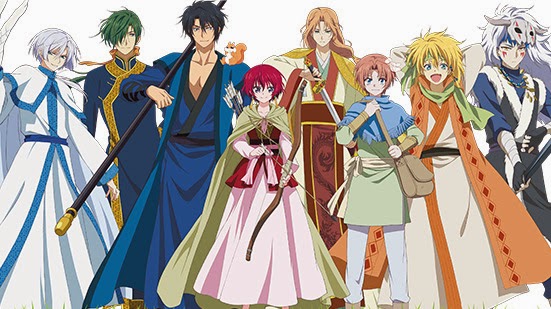Before you read this, I need you to go on YouTube. Search for “akatsuki shikata akiko.” It is the second ending theme for the anime adaptation of this manga.
Continue.
Magical girl twirling. The friendzone. The princess and her harem of male bodyguards. The princess blubbering and crying. The princess shooting 200 arrows a night to protect her childhood friend. The princess being protected by her loved ones. Body horror on the battlefield.
This is a shōjo manga by Kusanagi Mizuho.
In a tri-colored world as exemplary of good East Asian fusion as Avatar: The Last Airbender, the eponymous Princess Yona sets off with four legendary dragons in an anime sent off by a multi-voiced singer who can record up to 200 vocal tracks in a single song.
After discovering her childhood friend and crush, Su-won, killing her father, and barely fleeing Hiryuu Castle, the stronghold of the fictional Kingdom of Kōka, with her other childhood friend alive, the frail and spoiled Yona lives solely on two things. They are Hak, another childhood friend and bodyguard even in exile, and the whisper of a myth—the 2000 year-old origin of Kōka and the mythos of the manga.
The mythos points towards two things: That she is the reincarnation of the red-haired King Hiryuu, a dragon descended from heaven as a human, destined to rule Kōka again; and that she would be guarded by the descendants of his four bodyguards, or “dragons,” who each took on supernatural powers from Hiryuu’s companions in heaven.
The dragons are not hard to find despite being legends from Kōka’s version of King Arthur or Romance of the Three Kingdoms. The clutch of the story is in its friendship— and individual backgrounds, as Su-won the usurper turns out to be the king Kōka may very well need and Yona beats her frail body into that of a hardened warrior even Hak relies on.
As Yona travels through the country her father loved and finds the hardship faced by commoners, she confronts relatable realities for the first time: government corruption, hunger and a hint of fear mongering. These themes shape the backgrounds of the brotherly green dragon, Jaeha, who spent years avoiding her against an inherent instinct to serve Hiryuu; the taciturn blue dragon, Shin-ah, who despite being a genuinely gentle person spent his life hiding from his village and the overzealous white dragon Kija, who carries the spirits of past white dragons who died waiting for Hiryuu.
And I don’t dare talk about the yellow dragon, Zeno. Just love him as much as you can. His background will hurt the most.
Yona, for all her heart-stopping strength and royal bearing, remains humble and undemanding, willingly accepting Jaeha’s rejection. “I’m just asking for your help,” she says, unaware of how his dragon’s blood pulls him to her against his will. Hak, meanwhile, sinks deeper into the deck of the story, slowly becoming a wild card characterized by his wanting only to see Yona happy and bloodlust for his former friend Su-won.
But Su-won is the other wild card, a man who rules for the good of the people as well as the good of politics—an unsteady balance in stories and in life—perhaps better than the inexperienced Yona could. And Yona, for all her attempts at hatred towards him, cannot shake off a lifetime of love for her friend: an incredibly relatable feeling for anyone who has ended a close friendship.
Alongside character developments in the main timeline—between Shin-ah slowly learning to smile and the group’s companion, Yun, becoming the “mother” friend to the four dragons as they accept each other as brothers—Kusanagi never forgets to feed us more of the mythos, giving us glimpses at the backstories of the original four dragons. More heartbreak that needs to be adapted into anime.
Last of all, the culture of Kōka and its neighbors is a sly crash of ethnic diversity. While the coming war loosely bases off the Korean Three Kingdoms period, particularly in the resemblance of Su-won’s crown, Yona travels in clothes that at times look like a ruqun, commoner clothes worn as far back as China’s Warring States period. It surprisingly complements the appearance of Jaeha, whose clearly Korean name gives way to his preferred garb of changshan from the Chinese Qing Dynasty—imported from Kōka’s neighbor, Kai—and his habit of playing the erhu, another Chinese instrument. When Yona travels outside the kingdom’s borders there are hints of west Asian culture closer to Iran than to Japan, and even vaguer hints of north Asian culture between Mongolia and Russia.
Even Akatsuki seems to start with the light strains of an erhu.
Akatsuki no Yona is a cultured manga, a well-paced piece with enough crying to make the story believable and enough humor to lighten the mood. Only the first arc was animated last year, but reading ahead in the manga will definitely have you joining the league of fans crying for season two.




Comments are closed.